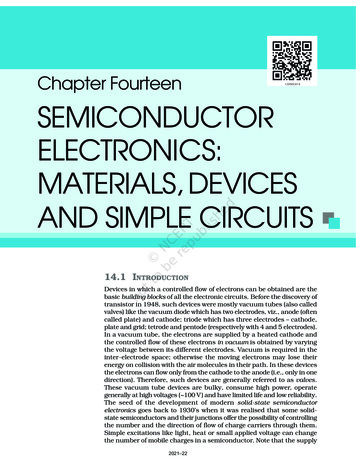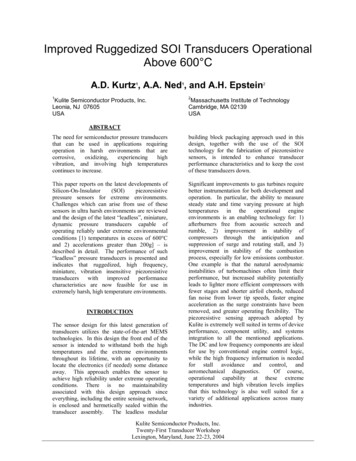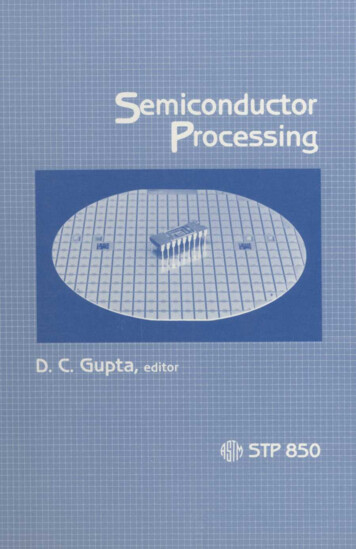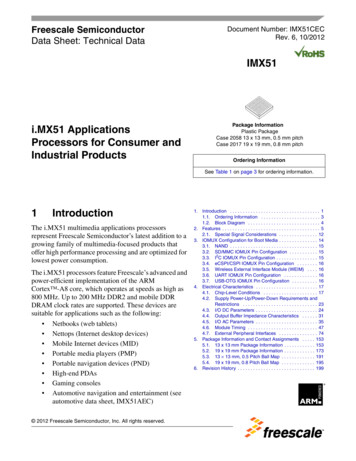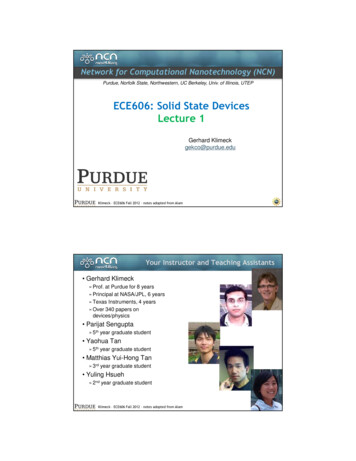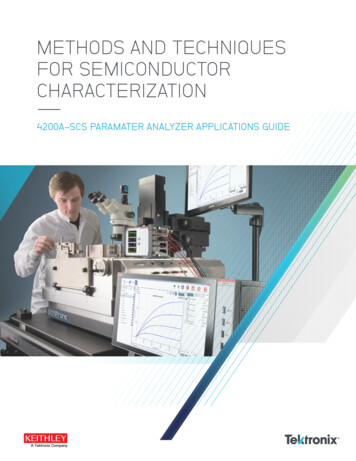
Transcription
METHODS AND TECHNIQUESFOR SEMICONDUCTORCHARACTERIZATION––4200A-SCS PARAMATER ANALYZER APPLICATIONS GUIDE
METHODS AND TECHNIQUES FOR SEMICONDUCTORCHARACTERIZATION APPLICATIONS GUIDETackle the challenges that can impede your measurements and introduce errors. The four applicationnotes in this semiconductor characterization applications guide offer tips and techniques for insight andunderstanding of DC semiconductor device performance.CONTENTSUsing the Model 4225-RPM Remote Amplifier/Switchto Automate Switching Between DC I-V, C-V, andPulsed I-V Measurements. 3An Ultra-Fast Single Pulse (UFSP) Technique for ChannelEffective Mobility Measurement. 7C‑V Characterization of MOS Capacitors Using the4200A-SCS Parameter Analyzer . 15Switching Between C-V and I-V Measurements Usingthe 4200A-CVIV Multi-Switch and 4200A-SCSParameter Analyzer. 29WWW.TEK.COM 1
Using the Model 4225-RPM Remote Amplifier/Switchto Automate Switching Between DC I-V, C-V, andPulsed I-V MeasurementsCharacterizing a device, material, or process electricallyoften requires performing multiple types of measurements,including DC I-V, C-V, and pulsed I-V tests. The 4200A-SCSParameter Analyzer can perform all of these measurementsusing a combination of 4200-SMU Source Measure Units,4210-CVU C-V Module, and 4225-PMU Ultra-Fast I-V Module.Once, combining these diverse measurement capabilities intoone system would have required re-cabling each module’soutput manually to the device under test (DUT) in betweenmeasurement types. The 4225-RPM Remote Amplifier/Switchsolves this problem by acting as a multiplexer, making itpossible to switch between precision DC SMUs, the CVU,or the Ultra-Fast I-V Modules automatically (Figure 1.)Figure 2. The output terminals of each 4225-RPM module connect toa single prober.Making ConnectionsThe SMUs, CVU, and PMU are connected to the inputterminals of the RPM using the cables supplied with theinstrument modules. The output terminals of the RPM areconnected to the DUT. Either two or four-wire connections canbe made. Each RPM comes with adaptors and one SMA cablefor two-wire measurements. Figure 3 shows the inputs andoutput connections of the 4225-RPM.Figure 1. 4200A-SCS with 4225-RPM Remote Amplifier/Switch accessories.RPM Output Terminalsto Device Under TestSMU, CVU, PMU toRPM Input TerminalsThe 4225-RPM is an accessory for the 4225-PMU 2-ChannelUltra-Fast I‑V Module. The 4225-RPM serves two purposes:to extend the 4225-PMU’s current measurements down to the100nA range and to allow switching between the 4200-SMU,4210-CVU, and 4225-PMU without re-cabling. The outputterminals of each 4225-RPM in the system are connectedto a single prober as shown in Figure 2. The 4225-RPMcan be mounted very close to the DUT, reducing cablecapacitance effects. The input terminals of the 4225-RPM areconnected to the modules in the 4200A-SCS.This application note explains how to use the 4225-RPM toFigure 3. Input and output connections of the 4225-RPM RemoteAmplifier/Switch.switch between the SMU, CVU, and PMU and make DC I-V,C-V, and pulsed I-V measurements on a single device. InThe schematic in Figure 4 illustrates the hardwareparticular, it describes hardware connections and how to useconnections from both the input and output terminals ofthe system software, Clarius, to configure and execute tests.the two 4225-RPMs. The DUT in this example is a diode.WWW.TEK.COM 3
Using Model 4225-RPM Remote Amplifier/Switch to SwitchAutomatically Between DC I-V, C-V, and Pulsed I-V MeasurementsAPPLICATIONS GUIDE4200- SMU Cables: 4200-TRX-2 or4200-MTRX-2 Triax to Triax Cables4200A-SCS CVUHI PotHI CurrLO CurrLO Pot4225-PMUCh. 1Ch. 2SMU14225-RPM 1CVU HI4225-RPM Cables:CA-534-24ATriax to Triax CablesSenseForcePMU CH1237-TRX-TTriax TeeDiode enclosed inconductive shieldconnected toForce LOSMU24225-RPM 2CVU LO4225-PMU: CA-547-2A RPMInterconnect CablesSenseForcePMU CH24210-CVU Cables:CA-447A SMA CablesFigure 4. Connections from the 4200A-SCS and 4225-RPMs to the diode.The output terminals of the two RPMs are connected to the diode in a four-wire configuration to provide the best measurementaccuracy and eliminate the effects of the lead resistance on the I-V and C-V measurements. These connections are made usingfour 24-inch triax cables (Keithley part number CS-534-24A). These triax cables have the performance needed for both lowcurrent (I-V) and high frequency (C-V and pulsed I-V) measurements. The Force and Sense output terminals from 4225-RPM Ch1are connected to the anode of the diode using two triax cables and a triax tee (237-TRX-T). The output terminals of 4225-RPMCh2 are connected to the cathode of the diode. To prevent noisy measurements, the diode should be enclosed in a conductiveshield that is connected to the Force LO terminal (the outside shield of the triax connector).Updating the RPM Configuration in the KCON ApplicationThe Keithley Configuration Utility (KCON) is used to manage and configure the 4200A-SCS, including the 4225-RPMs.Before using an RPM for automatic switching, it’s essential to update the RPM configuration usingthe KCON application located on the 4200A-SCS desktop. This will properly associate theinstruments connected to each RPM and will enable automatic switching between tests.To update the configuration, follow these steps:1.Make sure the device under test is disconnected fromthe outputs of the RPMs.2.Close the Clarius application.3.Open KCON (located on the desktop of the 4200A-SCS).4.Select “Update Preamp, RPM and CVIV Configuration” (see Figure 5.)5.Validate the configuration.6.Save the configuration.7.Close KCON application.4 WWW.TEK.COMFigure 5. Update RPMconfiguration in KCON.
Using Model 4225-RPM Remote Amplifier/Switch to SwitchAutomatically Between DC I-V, C-V, and Pulsed I-V MeasurementsAPPLICATIONS GUIDESetting Up the Measurements in the Clarius ApplicationOnce the hardware connections are made and the RPMs are configured in KCON, open the Clarius application and create aproject to switch automatically between DC I-V, C-V, and pulsed I-V measurements. Basically, just Select, Configure and Analyzethe measurements. In the following paragraphs, these three easy steps are described for creating a project to characterize adiode; however, the same procedure can be followed for other devices and tests, depending upon the application.1 Choose Select2 Select ProjectsSelect the Diode Project(Figure 6).Choose Select in the top left cornerof the screen. In the Library, select theProjects tab. Select the Diode in the3SelectDiodeFiltersFilters pane on the right-hand side ofthe screen. Select the Diode Project inthe Project Library and create a newproject when prompted.Select Diode4 ProjectFigure 6. Select the diode project.1 Choose ConfigureConfigure the Tests(Figure 7).The Diode Project has tests formeasuring I-V, C-V, and pulsed I-V.2 Select a test in the project treeEach test can be opened up andconfigured based upon the testrequirements. To configure each test,choose Configure in the top left-handcorner of the screen. Highlight the testto be configured. Highlight the terminalto modify the instrument settings.terminal to modify3 Highlightinstrument settingsMore detailed settings can be foundin the Test Settings and TerminalSettings tabs on the right-hand sideof the screen.Figure 7. Configure tests in the diode project.WWW.TEK.COM 5
Using Model 4225-RPM Remote Amplifier/Switch to SwitchAutomatically Between DC I-V, C-V, and Pulsed I-V MeasurementsAPPLICATIONS GUIDEAnalyze the Results (Figure 8).Once the tests are configured, the three tests can be executed consecutively. Start by selecting Analyze in the top left corner ofthe screen. This will bring up the Analyze pane in the center of the screen. To execute the tests sequentially, highlight the devicein the project tree and then select Run at the top of the screen. The tests will begin to run sequentially from the top of the projecttree. The RPMs will automatically switch the instrument outputs based on the test being executed.The screen shown in Figure 8 allows viewing the data in tabular format at the top of the pane or graphically at the bottom.This screen can also be configured for viewing only the data or the graph. On the right-hand side of the screen, the RunHistory pane allows selecting and analyzing the data and graphs taken from any previous executions of the test.1 Choose Analyze2 Run Test3Highlight testto view resultsFigure 8. Analyze the test results.ConclusionFully characterizing a device often requires precision DC I-V, C-V, and pulsed I-V measurements. Re-cabling betweenmeasurements can be a time-consuming manual process. The 4225-RPM Remote Amplifier/Switch option for the 4225-PMUsupports automatic switching between the PMU, CVU, and SMU modules installed in the 4200A-SCS chassis, saving valuabletime and avoiding the potential for re-cabling errors.6 WWW.TEK.COM
An Ultra-Fast Single Pulse (UFSP) Technique forChannel Effective Mobility MeasurementIntroduction(a)(b)The channel effective mobility (µeff) influences the MOSFETperformance through the carrier velocity and the drivingcurrent. It is one of the key parameters for complementarymetal-oxide-semiconductor (CMOS) technologies. It is widelyused for benchmarking different processes in technologydevelopment and material selection [1, 2]. It is also afundamental parameter for device modelling [3]. With deviceFigure 1. Configuration for (a) conduction current measurement and(b) gate-to-channel capacitance, Cgc, measurement.scaling down to the nano-size regime and the introductionof new dielectric materials, the conventional measurementtechnique for mobility evaluation encountered a numberof problems described in the following section, leading tosignificant measurement errors. As a result, a new mobilityextraction technique is needed.This application note describes a novel Ultra-Fast SinglePulse technique (UFSP) [4, 5] for accurate mobility evaluation,including the technique principle, how to connect the device,and how to use the Clarius software in the 4200A-SCSParameter Analyzer.Conventional Mobility Measurementand ChallengesWe use a p-channel device of gate length L and width W asThe principle of conventional mobility measurement isdeceptively simple. However, many challenges and pitfalls areassociated with this testing. Several sources of error are oftenignored in the past.Vd-dependence: The conventional technique applies anon-zero Vd (usually 50mV–100mV) for Ich measurement buta zero Vd for Qi measurement. This difference in Vd used intwo measurements can lead to significant errors in evaluatingmobility for thin oxides, especially in the low electric fieldregion. One example is given in Figure 2, where a higher Vd results in a substantial reduction of mobility near its peak.This is because Vg–Vd reduces for high Vd , so that thereal charge carrier density for the Ich is smaller than the Qimeasured at Vd 0.an example. When the channel charge is fairly uniform fromsource to drain in the linear region, the channel effective120mobility (µeff) can be written aswhere Vd is a small bias applied on the drain terminal of thedevice, Qi is the mobile channel charge density (C/cm2), and Ichis the conduction current flowing in the channel.Traditionally, Ich is measured at the drain terminal of the devicewith the configuration shown in Figure 1(a). Qi is extractedfrom integrating the measured gate-to-channel capacitance,Cgc, with respect to Vg, i.e.,by using the connection configuration shown in Figure 1(b).μeff (cm2/V-s)L Ichµeff · W Qi · VdVg100Id Vg configVdA80Vg6040 Ccg Vg configAVd -25 mVVd -50 mVVd -100 mV200024681012NS ( 10 cm )12-2Figure 2. Effective channel mobility measured by conventionaltechnique. Ich was measured under various non-zero drain biases,VDS, but Qi was measured under Vd 0. The extracted mobilityclearly reduces for higher Vd . Insets illustrate the carrier distributionin the channel.WWW.TEK.COM 7
An Ultra-Fast Single Pulse (UFSP) Technique forChannel Effective Mobility MeasurementAPPLICATIONS GUIDECharge Trapping: The conventional technique used slow0Vmeasurement with typical measurement time in seconds.The fast charge trapping becomes significant for both thinSiON and high-k dielectric. For slow measurements, trappingcan respond during the measurement and give rise tohysteresis and stretch-out of the Cgc–Vg curve and a reductionAAp p of Ich. This results in an underestimation of mobility.Vd -100mVVgn-subLeaky Dielectric: As gate oxide is downscaled, high gateleakage current becomes a main challenge for mobilityextraction. It affects both Ich and Qi measurements and inturn the mobility. To minimize its impact on Cgc measurement,frequencies up to gigahertz have been used, which requiresdevices with an RF structure. The RF structure requires moreFigure 3. Illustration of the working principle of UFSP technique.(a)processing and die space and is not always available.Cable Switching: The conventional technique involves cablechanging between Ich and Qi measurements. This slows downthe measurement and can potentially cause breakdown of thedevice under test.The Ultra-Fast Single Pulse Technique(UFSP Technique)(b)To overcome the challenges mentioned above, a noveltechnique called the Ultra-Fast Single Pulse technique (UFSP)has been developed and is described as follows.A p-channel device is used here for illustrating the workingprinciple of the UFSP technique as shown in Figure 3. Theconsiderations for n-channel devices are similar. To performFigure 4. Schematic diagram of current flow during the transientmeasurement.the UFSP measurement, a single pulse with edge time ofseveral microseconds is applied on the gate terminal of theTo facilitate the analysis, we define currents measured atdevice. The gate voltage sweeps toward negative during thedrain and source terminal during switching on and off as Idon,falling edge of the pulse and turns the device on. The transientIson, Idoff, and Isoff. The current flow in the channel during thecurrents are recorded at both the source and the draintransient measurement is shown in Figure 4 (a) and (b). Threeterminal of the device. The device is then switched off duringtypes of current are present: channel conduction current, Ich,the subsequent rising edge where the gate voltage sweepsdisplacement current between gate and source/drain, Idis s andtoward positive. The corresponding transient currents are alsoIdis d, and the leakage current between gate and source/drain,to be recorded. Channel effective mobility can be extractedIg s and Ig d. When device is switched off-to-on, the direction offrom these four transient currents measured within severalIdis s and Idis d is toward the channel center; Idis s has the samemicroseconds.direction as Ich at the source, but Idis d is in opposite directionto Ich at the drain. When the device is switched on-to-off, Idis sand Idis d change direction, but Ich does not. Ig s and Ig d areindependent of the Vg sweep direction and always flow fromthe source and drain towards gate under negative Vg. Basedon the above analysis, channel current, Ich, gate current, Ig, anddisplacement current, Idis can be separated by using Equations(2)–(4). Cgc can be calculated using (5).8 WWW.TEK.COM
An Ultra-Fast Single Pulse (UFSP) Technique forChannel Effective Mobility MeasurementICH IDON IDOFF ISON ISOFF4IG IG S IG D CGC IDISdVGdt(2) ISON ISOFF – IDON – IDOFF2IDIS IDIS S IDIS D APPLICATIONS GUIDEIDOFF– IDON(3) IS2ON– ISOFF(4) (5) To calibrate the UFSP technique, a p-channel MOSFETwith thick oxide is used that has negligible IG current.The measurement time ( edge time) is set at 3µs. Themeasured four currents are shown in Figure 5. The Ich, Ig120and Cgc extracted by using Equations (2) to (5) are shown in100be obtained by integrating Cgc against Vg and channel effectivemobility, μeff, is calculated through Equation (1) as shown inFigure 6(b).μeff (cm2/V-s)Figure 6(a). Once Cgc and Ich are evaluated accurately, Qi can806040200024Ns6(x101281012cm-2)Figure 6. (a) Ich, Ig, and Cgc extracted simultaneously from the currentsin Figure 5 by using Equations (2)–(5). (b) Channel effective mobilityextracted from Ich and Cgc from (a).Because the UFSP measured Ich and Cgc under the sameFigure 5. Four currents measured from source and draincorresponding to the off-to-on and on-to-off Vg sweep.Schematic Vg waveform is shown in inset.Vd, µeff should be independent of Vd. The µeff evaluated underthree different Vd biases is compared in Figure 7. Goodagreements are obtained confirming that the errors induced byVd using the conventional techniques have been removed.WWW.TEK.COM 9
An Ultra-Fast Single Pulse (UFSP) Technique forChannel Effective Mobility MeasurementAPPLICATIONS GUIDE50.06040Vd -25 mVVd -50 mV200Vd -100 mV024Ns681012( 1012 cm-2)Figure 7. The effective channel mobility, µeff, extracted under threedifferent Vd by using UFSP technique.50off-to-on and on-to-off VG sweep are shown in Figure 8 (a).By using Equations (2)–(5), Ich (‘n’), Ig (‘o’) and Cgc (‘x’) areextracted and plotted in Figure 8 (b). Ig from DC measurementis also plotted for comparison in Figure 8 (b). Good agreementis obtained. Figure 8 (c) shows that electron mobility can bereliably measured for this leaky device where Ig is as high as45A/cm2. Because the UFSP can tolerate high gate leakage,it does not require the use of the special RF structure formobility evaluation.I or Ig (μA)Ich or IchIch or Ig (μA)g (μA)from the source and drain terminals corresponding to the3030402020301010200010 000030030033Vg (V)nMOSFET. EOT 1.28nm3 3.52.52.532nMOSFET. EOT 1.28nmVd 50mVCgcCgcIch Cgc IgIchIgIchIg11V (V)gVg (V)1222 2.51.51.52111.50.50.51000.502Vg (V)3.53.5 32502503002002002502μeff2/V-s)2/V-s)μeff (cm(cm/V-s)μeff (cmMOSFET with an EOT of 1.28nm, the four currents measured350Vd 50mVEOT 1.28nm40 nMOSFET.50V 50mV40dThe UFSP also works well on leaky gate dielectric of standardstructure. When it was applied on one ‘leaky’ n-channelnMOSFET. EOT 1.28nm45.0W/L 10µm/10µm50.040.0nMOSFET.EOT 1.28nmVd 50mV45.035.0 W/L 10µm/10µm50.040.0nMOSFET.30.0 Vd 50mVIdon EOT 1.28nm45.035.0W/L 10µm/10µm25.040.0IsononVd Id 50mV30.020.0Isoff35.0Idoff I on25.0onIonssI15.030.0d20.0offIsoff IdoffIsonIdoff10.025.0Is Ison15.0onIdoff5.020.0IIsdoffIsoff10.0Idoff I onons15.00.0Id5.0offIsoff 12 Id10.0 00.0onV(V)Igd5.0012Vg (V)0.0012Cgc (µF/cm2)2Cgc (µF/cmCgc )(µF/cm2)80Current ( μ A)Current ( μA)Current( μ A)μeff (cm MOSFETEOT 1.28nmEOT 1.28nm 50mVVdVd 50mVnMOSFETEOT 1.28nm20 50mV101020Vd30 3012 cm12-2) -2)NsN( 10s ( 10cm1020Ns ( 1012 cm-2)30Figure 8. (a) Four currents measured from the source and draincorresponding to the off-to-on and on-to-off Vg sweeps by UFSPtechnique on an nMOSFET with EOT of 1.28nm.(b) Ich (‘n’), Ig (‘o’) and Cgc (‘x’) are extracted from the currents in(a) with Equations (2)-(5). The blue line is the leakage currentobtained by DC measurement.(c) Channel effective mobility, µeff, is calculated by using the extractedIch and Cgc with Eqn (1).10 WWW.TEK.COM
An Ultra-Fast Single Pulse (UFSP) Technique forChannel Effective Mobility MeasurementAPPLICATIONS GUIDETo demonstrate the applicability of UFSP to devices within Figure 10. The 4225-PMU is the latest addition to thesignificant charge trapping, one pMOSFET with an HfO2/SiO2growing range of instrumentation options for the 4200A-SCSstack was used. Large amount of traps locate close toParameter Analyzer. The module integrates ultra-fast voltagethe Si/SiO2 interface in this dielectric stack and they canwaveform generation and signal observation capabilitiesexchange charges with the substrate rapidly. The conventionalinto the 4200A-SCS’s already powerful test environment totechnique takes seconds, making them indistinguishable fromdeliver unprecedented I-V testing performance. It makeschannel mobile charges. As a result, inversion charges willultra-fast I-V sourcing and measurement as easy as makingbe overestimated and in turn the channel effective mobilityDC measurements with a traditional high resolution sourcewill be underestimated. The UFSP technique only takesmeasure unit (SMU) instrument. Each plug-in 4225-PMUmicroseconds, minimizing charge trapping effect. Figure 9module provides two channels of integrated sourcing andcompares the mobility extracted by these two techniques. Itmeasurement. Each channel of the 4225-PMU combines highclearly shows that after suppressing the trapping, the mobilityspeed voltage outputs (with pulse widths ranging from 60extracted from the UFSP is considerably higher than that bynanoseconds to DC) with simultaneous current and voltagethe conventional technique.measurements. The 4225-RPM Remote Amplifier/Switchfurther expands the 4225-PMU’s capabilities by providingultra-low current measurement (below 100nA) and reducing10080μeff (cm 2/V-s)cable capacitance effects.7% increases@ low E6020% increases@ high E40UFSP techniqueConventional techique20014710 13 16 19Ns ( 1012 cm-2)2225Figure 9. A comparison of mobility extracted by UFSP andconventional technique for a device with HfO2/SiON dielectric ofconsiderable fast trapping.Required Hardware for UFSPMeasurementFigure 10. UFSP technique setup.Connections to the DeviceSelecting appropriate measurement equipment is critical toThe connection for the UFSP measurement is shown inthe successful implementation of theh ultra-fast single pulseFigure 11. Each terminal of the device is connected to onemethod. The following hardware is required:4225-RPM using two 11-inch triaxial cables (provided in the One Model 4200A-SCS Parameter Analyzer, with Two Ultra-Fast I-V Modules (4225-PMU);cable set 4210-MMPC-C). Then each 4225-RPM is connectedto one channel of the PMU using two triaxial cables. All themeasurements are controlled by the Clarius software. Four Remote Amplifier/Switches (4225-RPM); 4 High Performance Triaxial Cable Kits (4210-MMPC-C).A photo of the cabling configuration for the test is shownWWW.TEK.COM 11
An Ultra-Fast Single Pulse (UFSP) Technique forChannel Effective Mobility MeasurementAPPLICATIONS GUIDEFigure 11. Experiment connection for the Ultra-fast Single Pulse (UFSP) technique. Two Keithley dual-channel 4225-PMUs are used for performingtransient measurements. Four Keithley 4225-RPMs are used to reduce cable capacitance effect and achieve accurate measurement below 100nA.Figure 12. Example project in the Clarius software for UFSP measurement. Each of the four terminals of the device is connected to one channelof PMU respectively.12 WWW.TEK.COM
An Ultra-Fast Single Pulse (UFSP) Technique forChannel Effective Mobility MeasurementAPPLICATIONS GUIDEUsing Clarius Software to Perform UFSP MeasurementsPerforming UFSP for channel effective mobility measurement using the 4200A-SCS system is quite simple. An example projectis included with the system. As shown in Figure 12, each terminal of the device is connected to one channel of the PMU. Userscan modify the parameters for each PMU channel in the definition tab. Table 1 lists one set of user-defined parameters for ap-channel MOSFET.In the Test Setings pane, users can input the desired measurement speed which is the edge time of the pulse.The recommended values are listed in Table 2.Table 1. Recommended settings in the definition tab for each channel of the PMPMU Setting for Gate TerminalValueDescriptionForcing FunctionPulse TrainTo generate a single pulse or a pulse train with same shapeVoltage Amplitude–2VTo define the Vg sweep rangeVoltage Base0VVrange10VMaximum possible voltage applied on the gateIrange10µAMeasurement range for currentSample I waveformuntickDo not record current at the gateSample V waveformtickRecord applied voltage at the gateTimestamptickRecord total time for the measurementParametersPulse Train SettingsMeasurement RangeMeasurement SettingPMU Setting for Drain TerminalValueDescriptionForcing FunctionPulse Train To generate a single pulse or a pulse train with the same shapePulse Train SettingsDC voltageTo apply a constant Vd bias used for mobility measurementVoltage base (V)–0.1Vrange10VMaximum possible voltage applied on the gateIrange10µAMeasurement range for currentSample I waveformtickRecord current at the drainSample V waveformuntickDo not record applied voltage at the drainTimestampuntickDo not record total time for the measurementParametersPulse Train SettingsMeasurement RangeMeasurement SettingPMU Setting for Source TerminalValueDescriptionForcing FunctionPulse Train To generate a single pulse or a pulse train with the same shapePulse Train SettingsDC voltageTo apply a zero Vs bias used for mobility measurementVoltage base (V)0Vrange10VMaximum possible voltage applied on the gateIrange10µAMeasurement range for currentSample I waveformtickRecord current at the sourceSample V waveformuntickDo not record applied voltage at the sourceTimestampuntickDo not record total time for the measurementParametersMeasurement RangeMeasurement SettingPMU Setting for Bulk TerminalValueDescriptionForcing FunctionPulse Train To generate a single pulse or a pulse train with the same shapePulse Train SettingsDC voltageTo apply a zero Vbulk bias used for mobility measurementVoltage base (V)0Sample I waveformuntickDo not record current at the bulkSample V waveformuntickDo not record applied voltage at the bulkTimestampuntickDo not record total time for the measurementParametersMeasurement SettingWWW.TEK.COM 13
An Ultra-Fast Single Pulse (UFSP) Technique forChannel Effective Mobility MeasurementAPPLICATIONS GUIDETable 2. Recommended settings in the timing tab.ParametersTest ModeValueWaveform captureMeasurement ModeDiscrete PulsesSweep parameterPeriod (s)Width (s)Rise Time (s)Fall Time (s)Pulse Delay criptionDiscrete Pulse and Average pulses, then you need toinput number of Pulses, 10 is enough.No sweeping requiredPeriod of the pulsePulse widthPulse rise timePulse fall time, set to be the same as rise timePulse delay time, keep the same as rise timeOnce the test is executed, transient currents during switchingReferenceson and off at source and drain terminals will be recorded and1.P. R. Chidambaram, C. Bowen, S. Chakravarthi, C.Machala, and R. Wise, “Fundamentals of silicon materialproperties for successful exploitation of strain engineeringin modern CMOS manufacturing,” IEEE Trans. ElectronDev., vol. 53, no. 5, pp. 944-964, 2006.2.R. Chau, S. Datta, M. Doczy, B. Doyle, J. Kavalieros, andM. Metz, “High-kappa/metal-gate stack and its MOSFETcharacteristics,” IEEE Electron Dev. Lett., vol. 25, no. 6,pp. 408-410, Jun, 2004.3.K. Chain, J. Huang, J. Duster, K. K. Ping, and C. Hu,“A MOSFET electron mobility of wide temperature range(77 - 400 K) for IC simulation,” Semiconductor Scienceand Technology, vol. 12, no. 4, pp. 355, 1997.4.Z. Ji, J. F. Zhang and W. Zhang, “A New MobilityExtraction Technique Based on Simultaneous Ultrafast IdVg and Ccg-Vg Measurements in MOSFETs,” IEEE Trans.Electron Dev., vol. 59, no. 7, pp. 1906, 2012.5.Z. Ji, J. Gillbert, J. F. Zhang and W. Zhang, “A newUltra-Fast Single Pulse technique (UFSP) for channeleffective mobility evaluation in MOSFETs,” IEEE Int.stored in the sheet and can be saved as an .xls file. Thesecurrents can also be plotted on the graph tab. From thesecurrents, the channel effective mobility can be extractedbased on Equations (2) to (5).ConclusionChannel carrier mobility is a key parameter for materialselection and process development. The conventionaltechnique suffers from several shortcomings: slow speed andvulnerability to fast trapping, Vd-dependence, cable-changing,sensitivity to gate leakage, and a complex procedure. An ultrafast single pulse technique (UFSP) has been proposed anddeveloped to overcome these shortcomings. ICH and Qi can besimultaneously measured within several microseconds withoutcable switching. UFSP measurement can be easily performedusing the 4200A-SCS Parameter Analyzer with two 4255PMUs and four 4225-RPMs. It provides a complete solutionfor robust and accurate mobility evaluation in a convenientway and serves as a tool for process development, materialselection, and device modelling for CMOS technologies.Conf. Microelectronic Test Structures, pp. 64, 2013.AcknowledgementsAuthor: Dr. Zhigang Ji, School of Engineering, LiverpoolJohn Moores University14 WWW.TEK.COM
C‑V Characterization of MOS Capacitors Usingthe 4200A-SCS Parameter AnalyzerIntroductionMaintaining the quality and reliability of gate oxides ofOverview of C-V MeasurementTechniqueMOS structures is a critical task in a semiconductor fab.By definition, capacitance is the change in charge (Q) in aCapacitance-voltage (C‑V) measurements are commonly usedin studying gate-oxide quality in detail. These measurementsdevice that occurs when it also has a change in voltage (V):C are made on a two-terminal device called a MOS capacitor(MOS cap), which is basically a MOSFET without a source and Q Vdrain. C‑V test results offer a wealth of device and processOne general practical way to implement this is to apply a smallinformation, including bulk and interface charges. Many MOSAC voltage signal (millivolt range) to the device under test, anddevice parameters, such as oxide thickness, flatband voltage,then measure the resulting current. Integrate the current overthreshold voltage, etc., can also be extracted from thetime to derive Q and then calculate C from Q and V.C‑V data.C-V measurements in a semiconductor device are made usingUsing a tool such as the Keithley 4200A-SCS equippedtwo simultaneous voltage sources: an applied AC voltagewith the 4210-CVU I
Using the Model 4225-RPM Remote Amplifier/Switch to Automate Switching Between DC I-V, C-V, and . notes in this semiconductor characterization applications guide offer tips and techniques for insight and understanding of DC semiconductor device performance. . The screen shown in Figure 8 allows v



